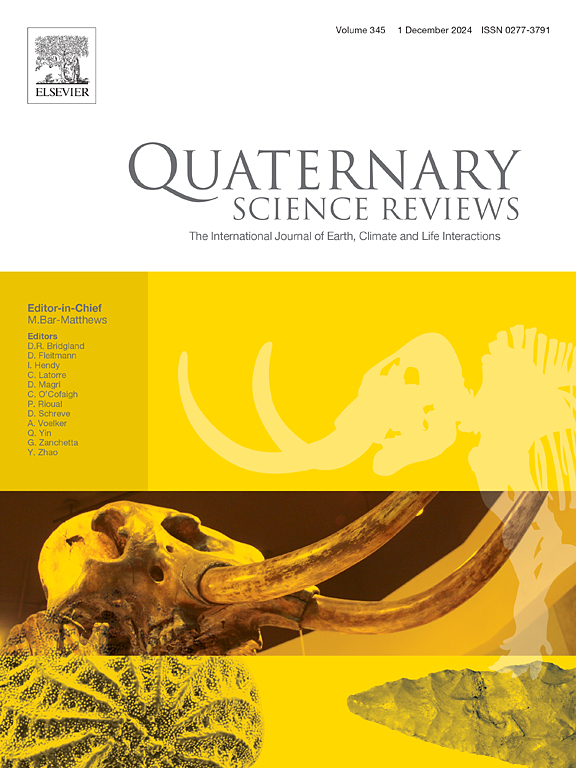Reconstructing Late Pleistocene relative sea levels on transgressed shelves: an example from central California
IF 3.2
1区 地球科学
Q1 GEOGRAPHY, PHYSICAL
引用次数: 0
Abstract
Although prevalent for the late Holocene, relative sea level (RSL) constraints during and immediately after the Last Glacial Maximum (LGM) are sparse. This scarcity of data is particularly pronounced along mid-latitude shelves such as central California, which lack post LGM RSL constraints older than 12 ka. In this study we collected 7 sediment cores and high-resolution seismic data from Estero Bay to constrain RSLs across the central California shelf between ∼9 and ∼16 ka. We reconstructed these RSLs using two sea-level indicators found within our sediment cores: the wave ravinement shell hash burial surface (WRSHBS) and the sedimentary contact between offshore mud facies and ripple cross-laminated sands. To determine the indicative meaning of these two sea-level indicators, we examined the relationship between the local wave regime, modern bathymetric profiles, and the depth of preservation of each sea-level indicator. After correcting for tectonic uplift, we estimated sea levels in central California to have been ∼39 ± 7.5 and 49 ± 7.5 m below present sea level between 9 and 12 ka, in agreement with previous RSL reconstructions along this coast. Between 13.8 and 15.9 ka, we estimate sea levels to have reached ∼86 ± 8–99 ± 8 m below present sea level. Our findings offer a Late Pleistocene RSL reconstruction for central California and develop new methodologies for estimating past RSLs on similar mid-latitude shelves.
海侵陆架上晚更新世相对海平面的重建:以加利福尼亚中部为例
尽管在全新世晚期普遍存在,但末次盛冰期期间和之后的相对海平面(RSL)限制很少。这种数据的缺乏在加利福尼亚中部等中纬度大陆架上尤为明显,这些大陆架缺乏超过12 ka的LGM后RSL约束。在这项研究中,我们从埃斯特罗湾收集了7个沉积物岩心和高分辨率地震数据,以限制加州中部大陆架在~ 9至~ 16 ka之间的RSLs。我们利用在沉积物岩心中发现的两个海平面指标重建了这些RSLs:波浪冲刷壳散埋面(WRSHBS)和近海泥相与波纹交叉层状砂之间的沉积接触。为了确定这两个海平面指标的指示意义,我们研究了当地波浪状况、现代水深剖面和每个海平面指标保存深度之间的关系。在对构造隆起进行校正后,我们估计加利福尼亚中部的海平面在9至12 ka之间比现在的海平面低~ 39±7.5和49±7.5 m,这与之前沿该海岸的RSL重建结果一致。在13.8至15.9 ka之间,我们估计海平面已达到比现在海平面低~ 86±8 - 99±8 m。我们的发现提供了加利福尼亚中部晚更新世的RSL重建,并开发了新的方法来估计类似中纬度大陆架上过去的RSL。
本文章由计算机程序翻译,如有差异,请以英文原文为准。
求助全文
约1分钟内获得全文
求助全文
来源期刊

Quaternary Science Reviews
地学-地球科学综合
CiteScore
7.50
自引率
15.00%
发文量
388
审稿时长
3 months
期刊介绍:
Quaternary Science Reviews caters for all aspects of Quaternary science, and includes, for example, geology, geomorphology, geography, archaeology, soil science, palaeobotany, palaeontology, palaeoclimatology and the full range of applicable dating methods. The dividing line between what constitutes the review paper and one which contains new original data is not easy to establish, so QSR also publishes papers with new data especially if these perform a review function. All the Quaternary sciences are changing rapidly and subject to re-evaluation as the pace of discovery quickens; thus the diverse but comprehensive role of Quaternary Science Reviews keeps readers abreast of the wider issues relating to new developments in the field.
 求助内容:
求助内容: 应助结果提醒方式:
应助结果提醒方式:


